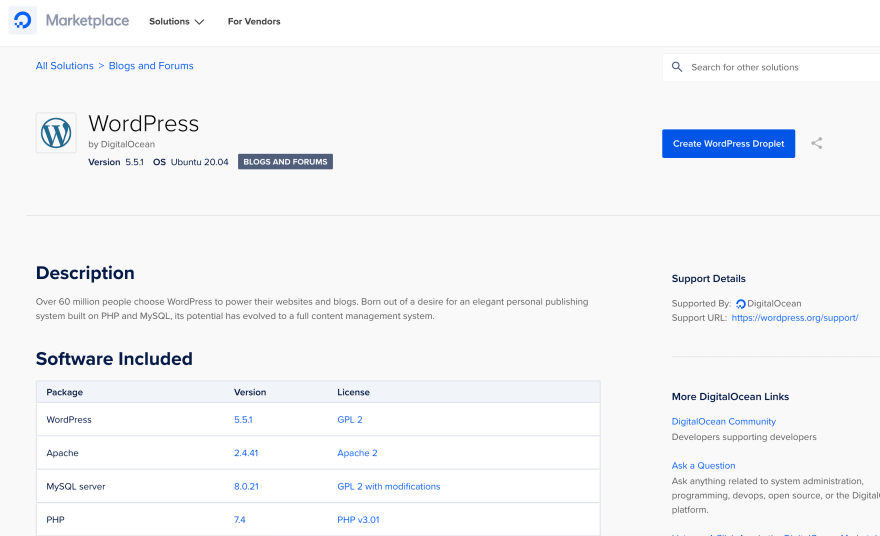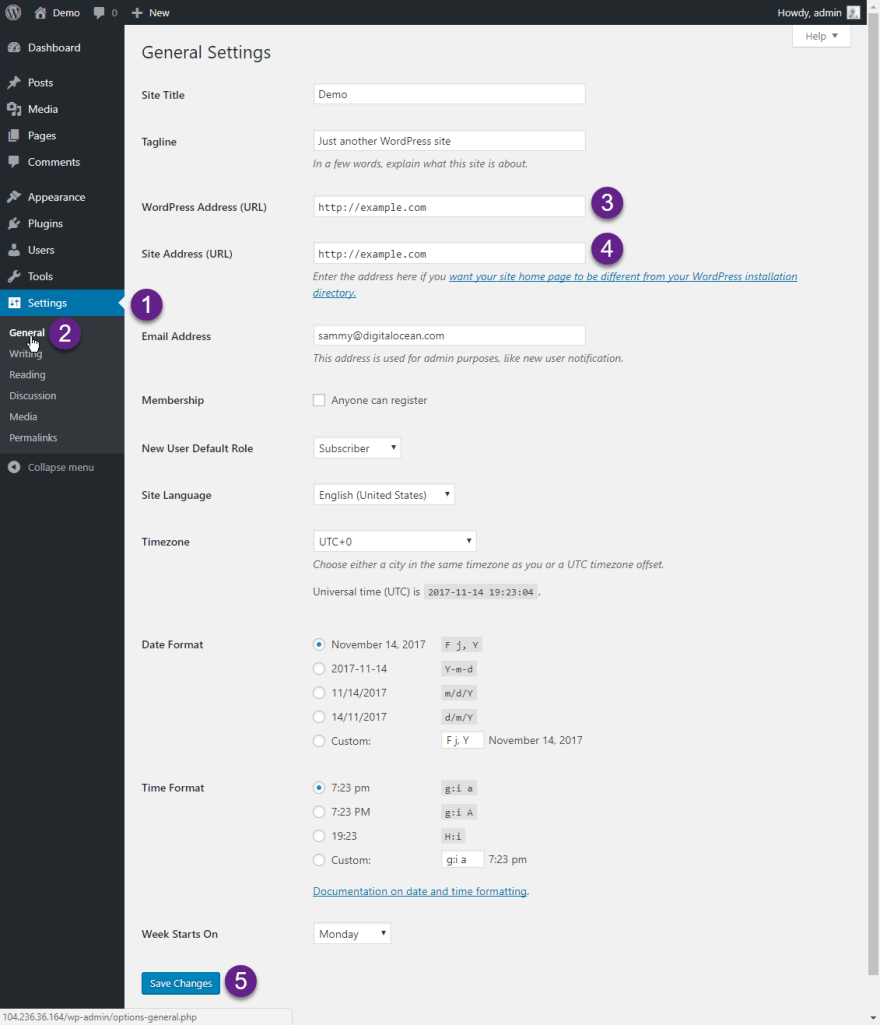Introduction
WordPress is one of the most popular content management and blog platforms in the world, allowing you to create and manage website content efficiently.
This tutorial will share all the details you need to get your WordPress site set up using the WordPress 1-Click App.
Software Included
In addition to the features installed in a regular Ubuntu 20.04 Droplet, the WordPress 1-Click image also includes the following components:
Apache: The most widely used web (HTTP) server.
MySQL: A commonly used open-source relational database.
PHP: PHP language support.
These components create the LAMP stack, a group of open source software typically installed together to enable a server to host dynamic websites like WordPress. The term LAMP is an acronym that represents the configuration of a Linux operating system with an Apache web server, with site data stored in a MySQL database and dynamic content processed by PHP.
To improve security, the following additional components are included:
- UFW: A program to simplify the management of a firewall.
- fail2ban: A service that automatically updates your firewall configuration to block attackers.
In this tutorial, we'll create a Wordpress 1-Click Droplet, then explain how to set up your WordPress site, configuring the domain and sharing information on how to access the MySQL database.
Step 1 — Creating A WordPress Droplet
To create a Wordpress Droplet from the 1-Click App page, press the Create WordPress Droplet button:
This takes you to the Create Droplets page, where you can customize your settings before creating your WordPress Droplet. How to Create your First Droplet describes each choice in detail. Below, we'll highlight key settings:
Choose an image:
If not already set, you'll need to switch from the Distributions tab to the Marketplace tab:
Once there, WordPress 5.5.1 on Ubuntu 20.04 should be automatically selected. If not, click “WordPress 5.5.1 on Ubuntu 20.04” to select it as the image.
Once the image is highlighted, you can accept the defaults or adjust settings according to your use case. We recommend the following changes:
Choose a plan:
Choose the size you need here — Wordpress One-Click Droplets require 1GB of RAM or more.
Add block storage:
Learn more about block storage and add this to your droplet based on your use case.
Choose a datacenter region:
Generally, choose the data center closest to your user base.
Select additional options:
We recommend selecting Monitoring, a free service that will help you follow Droplet resource usage over time. You may also want to consider enabling automated backups. You can enable this now or anytime in the future.
Choose a hostname:
You can make it easier to identify the Droplet by naming it "WordPress," or naming it after the site you plan to host.
When you've made your choices, click Create Droplet.
Once the Droplet is created, its address will be displayed:
Click the address to copy it to your clipboard. In the next step, we'll use this to view the WordPress site.
Step 2 — Checking the Placeholder Page
Open a web browser and paste the Droplet's IP address into the location bar to visit your new site. Until you log in with SSH, the following page will appear:
This security measure has been put in place to protect the initial configuration of WordPress, in which the administrative user is set up.
You can safely leave the installation in this state until you are ready to configure WordPress.
Step 3 — Accessing the Droplet via SSH to Enable Configuration
To remove the placeholder web page, you’ll first need to connect to the Droplet via SSH. Once you connect, it's important to complete the WordPress configuration promptly. Until you do, anyone who finds your site could create the administrative user and password.
To begin, you’ll connect directly to the server from the command line— you’ll need to complete this task once in order to configure WordPress. If you haven't used a terminal program like SSH or PuTTY before, check out How To Connect To Your Droplet with SSH.
When you're ready, open a terminal on your computer and log into your Droplet as root (or your administrative user) via SSH with this command (substitute with your Droplet's IP address):
ssh <^>root<^>@<^>droplet.ip.address<^>
After the first successful SSH login, you're ready to set your administrative password and configure WordPress.
Note:
You will be prompted to enter your administrative details on the terminal after logging in via SSH or temporary password. You can follow the terminal instructions to finish configuring WordPress, or use the graphical user interface configuration process that’s explained in the next step.
Step 4 — Configuring WordPress
After WordPress installation has been enabled by logging into the Droplet via SSH, visit the Droplet's IP address in a web browser. You should see the following page:
Follow the on-screen prompts to select the language, give the site a name, and configure its administrative user. Be sure to set a strong password for added security.
Once you have completed the initial configuration, you can log in as the administrative user you just created and continue to set up your site.
Step 5 — Configuring a Domain
To use a domain name instead of the IP address of your Droplet, follow the steps in How To Set Up a Host Name with DigitalOcean or set up a domain name with your own DNS provider. Either way you connect your domain name to your WordPress Droplet, once it resolves using DNS, you will need to update the WordPress configuration to use the domain.
Log in to your WordPress admin panel at http://<^>DROPLET_IP_ADDRESS<^>/wp-admin using the admin account you created earlier. Click on General under Settings in the navigation bar on the left-hand side of the page. Here, you will see several options you can configure for your site. Update the WordPress Address (URL) and Site Address (URL) fields to reflect your new domain name and click Save Changes.
You can customize your site's appearance, install plugins for added functionality, or create a new post or a page.
Step 6 — Locating Logins and Passwords
Additional details of your installation are provided in the MOTD (Message of the Day) which is displayed when you log into your Droplet via SSH:
-------------------------------------------------------------------------------
Welcome to DigitalOcean's One-Click WordPress Droplet.
To keep this Droplet secure, the UFW firewall is enabled.
All ports are BLOCKED except 22 (SSH), 80 (HTTP), and 443 (HTTPS).
-------------------------------------------------------------------------------------
If you need to access your MySQL database server you can find your MySQL root user password in the /root/.digitalocean_password file with the following command:
cat /root/.digitalocean_password
[secondary_label Output]
root_mysql_pass="<^>c404aed5e912278adb4EXAMPLE9782f390286d706a9c4f72<^>"
wordpress_mysql_pass="619863e454cEXAMPLE15be13d9730db5c0a52ad6a4d2491a"
Copy the password, located inside the quotation marks on the line that begins root_mysql_pass. Next run the mysql command with the -u flag to specify a user (root) and the -p flag to be prompted for the password as follows:
mysql -u root -p
When prompted, paste in the password you copied.
If you prefer to use a graphical user interface, follow the tutorial How To Install and Secure phpMyAdmin on Ubuntu 18.04.
Conclusion
Your WordPress site should be up and running. You can enhance its security by following our Initial Server Setup guide to give sudo privileges to your user, lock down root login, and take other steps to make your Droplet ready for production.









Top comments (0)